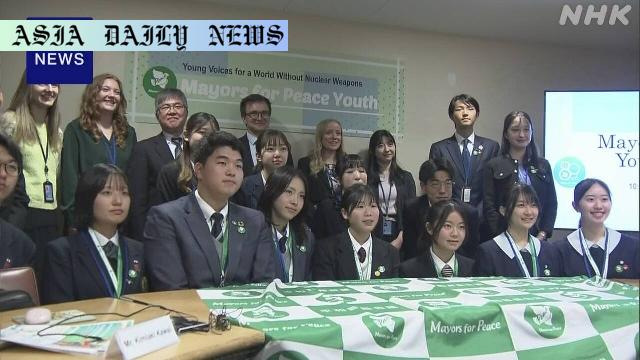Nuclear-Free World: Japanese youths advocate for a safer future at the United Nations and engage in global peace initiatives.

Voices for a Nuclear-Free World at the United Nations
On Tuesday, a compelling call for a nuclear-free world was made by students from Hiroshima and Nagasaki during a meeting organized by the Mayors for Peace at the United Nations in New York. The meeting served as an adjunct to the preparatory committee discussions for the upcoming review conference of the Nuclear Non-Proliferation Treaty. These young individuals, representing cities that bore the devastating atomic bombings of 1945, shed light on their aspirations for peace and the urgency of nuclear disarmament.
Attendees, including high school and university students, emphasized their unique role as the last generation able to hear the firsthand accounts of the hibakusha—survivors of the atomic bombings. These survivors, now over 85 on average, shared harrowing stories of suffering that include lifelong battles with health conditions such as leukemia. By highlighting these truths, the students stressed the importance of preserving their stories as a crucial component of peace education and advocacy.
Global Collaboration for Disarmament
Apart from addressing esteemed UN representatives and fellow youth, the Japanese students benefitted from cross-cultural exchanges with other young activists. Kawamura Hanon, a third-generation hibakusha from Hiroshima, expressed how these discussions broadened her understanding of peace education practices worldwide. Inspired by these dialogues, she is now determined to reformulate Japan’s peace education framework to make it more impactful and resonate deeply with newer generations.
Recognizing the passion and determination of these youths, UN Under-Secretary-General and High Representative for Disarmament Affairs, Nakamitsu Izumi, commended their efforts. She emphasized that young people hold the right to demand a safer and more secure future and praised their role in shaping tomorrow’s policies.
The Relevance of Witness Testimonies in Driving Change
The atrocities faced by the hibakusha remain a potent reminder of the catastrophic effects of nuclear weapons, driving the necessity for stringent disarmament measures. The students pointed out how survivors continue to live with both physical and emotional scars decades after the bombings. These stories are not merely personal; they serve as a poignant plea to ensure that the world never witnesses such horrors again. Their testimonies, shared to younger generations globally, are a beacon of hope and a call to action against nuclear armament.
As these students took the stage, they symbolized a new wave of activism—bridging the legacy of the hibakusha with an international call to prevent nuclear proliferation. Their message resonated across borders, uniting young people worldwide in the shared pursuit of a nuclear-free world.
Building the Road Ahead
The Hiroshima and Nagasaki students’ journey to the UN symbolizes the responsibility placed on younger generations to carry forward the lessons of history. Their participation at one of the world’s most pivotal platforms signifies progress, but the road ahead is long. Central to achieving a nuclear-free world is fostering global solidarity and educating younger generations on the consequences of nuclear warfare and the value of disarmament.
Engagements like these also highlight the collaborative effort required: youth advocacy, government action, and international cooperation. Understanding diverse approaches and integrating best practices into peace education programs worldwide can amplify the cause. By uniting these efforts, future generations can be equipped to demand and enact meaningful change.
The Power of Youth-Led Advocacy
The presence of young voices at highly influential forums such as the United Nations exemplifies the growing influence of youth-led campaigns in shaping global narratives. Their ability to forge new collaborations, leverage technology to amplify messages, and challenge the status quo gives them a pivotal role in global peace advocacy. With passion and resilience, these young advocates are not just participants but torchbearers of a collective movement aiming for a nuclear-free future.
The momentum generated by such initiatives underscores the necessity of continuous dialogue and action. By supporting and amplifying youth voices, stakeholders worldwide can catalyze the change needed to advance disarmament and sustain global peace for generations to come.
Commentary
The Role of Youth in Shaping a Nuclear-Free Future
The advocacy by students from Hiroshima and Nagasaki at the United Nations signals a profound shift in how younger generations engage with historic global issues. These young individuals are not merely custodians of their cities’ traumatic histories but are also catalysts for worldwide movements advocating peace and disarmament. Their ability to present a unified voice at such a critical platform reflects a readiness to shape policies that align with their vision of the future.
Why Preserving the Voices of Hibakusha Matters
The significance of preserving hibakusha testimonies cannot be overstated. These narratives serve as a stark reminder of the devastating human cost of nuclear warfare. For a generation that did not experience these events, the stories of survivors forge a vital connection to history, grounding abstract discussions about disarmament into real, human-centered tragedies. The initiative by students to ensure the continuation of these testimonies demonstrates their commitment to using history as a tool for meaningful advocacy.
Global Collaboration: A Transformative Approach
One of the most encouraging aspects of this initiative is the global collaboration facilitated by such meetings. Young voices from various backgrounds sharing ideas and strategies emphasizes the universality of the call for peace. It also provides invaluable opportunities to incorporate diverse perspectives on peace education, creating robust frameworks adaptable across cultural contexts.
The Long Road Ahead
While the efforts of these students are inspiring, the journey toward achieving a nuclear-free world remains complex. It requires a multipronged approach involving advocacy, education, and political will. Nevertheless, initiatives such as this serve as beacons of hope, reminding us of the powerful role that youth can play in driving transformative change and safeguarding the future for all humanity.


